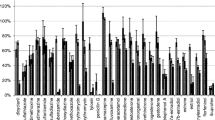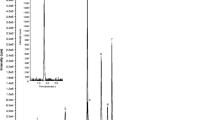Abstract
Agricultural intensification, and in particular the use of pesticides, leads over the years to a loss of biodiversity and a decline of ecosystem services in cultivated zones and agricultural landscapes. Among the animal communities involved in the functioning of agro-ecosystems, earthworms are ubiquitous and recognized as indicators of land uses and cultural practices. However, little data is available on the levels of pesticides in such organisms in natura, which would allow estimating their actual exposure and the potentially resulting impacts. Thus, the objective of this study was to develop a sensitive analytical methodology to detect and quantify 27 currently used pesticides in earthworms (Allolobophora chlorotica). A modified QuEChERS extraction was implemented on individual earthworms. This step was followed by liquid chromatography coupled to tandem mass spectrometry (LC-MS/MS). The whole analytical method was validated on spiked earthworm blank samples, with regard to linearity (from 1 to 100 method limit of quantification, r2 > 0.95), intra-day precision (relative standard deviation (RSD) < 15%), inter-day precision (RSD < 20%), recoveries (mainly in the range 70–110%), and limits of detection and of quantification (inferior to 5 ng/g for most of the pesticides). The developed method was successfully applied to determine the concentrations of pesticides in nine individuals collected in natura. Up to five of the selected pesticides have been detected in one individual.

Graphical abstract



Similar content being viewed by others
References
Arias-Estévez M, López-Periago E, Martínez-Carballo E, Simal-Gándara J, Mejuto J-C, García-Río L. The mobility and degradation of pesticides in soils and the pollution of groundwater resources. Agric Ecosys Environ. 2008;123(4):247–60.
Druart C, Millet M, Scheifler R, Delhomme O, Raeppel C, de Vaufleury A. Snails as indicators of pesticide drift, deposit, transfer and effects in the vineyard. Sci Tot Environ. 2011;409(20):4280–8.
Jensen PK, Olesen MH. Spray mass balance in pesticide application: a review. Crop Protec. 2014;61:23–31.
Blouin M, Hodson ME, Delgado EA, Baker G, Brussaard L, Butt KR, et al. A review of earthworm impact on soil function and ecosystem services. Eur J Soil Sci. 2013;64:161–82.
Pelosi C, Toutous L, Chiron F, Dubs F, Hedde M, Muratet A, et al. Reduction of pesticide use can increase earthworm populations in wheat crops in a European temperate region. Agric Ecosys Environ. 2013;181(1):223–30.
Katagi T, Ose K. Toxicity, bioaccumulation and metabolism of pesticides in the earthworm. J Pestic Sci. 2015;40(3):69–81.
Singh S, Singh J, Vig AP. Earthworm as ecological engineers to change the physico-chemical properties of soil: soil vs vermicast. Ecolog Engin. 2016;90:1–5.
Hickman ZA, Reid BJ. Earthworm assisted bioremediation of organic contaminants. Environ Intern. 2008;34(7):1072–81.
King RA, Vaughan IP, Bell JR, Bohan DA, Symondson WOC. Prey choice by carabid beetles feeding on an earthworm community analysed using species- and lineage-specific PCR primers. Mol Ecol. 2010;19:1721–32.
Ellis SR, Hodson ME, Wege P. The soil-dwelling earthworm Allolobophora chlorotica modifies its burrowing behaviour in response to carbendazim applications. Ecotox Environ Saf. 2010;73(6):1424–8.
Yasmin S, D’Sousa D. Effects of pesticides on the growth and reproduction of earthworm: a review. Applied and Environ Soil Sci 2010; pages 9 doi:https://doi.org/10.1155/2010/678360.
Pisa LW, Amaral-Rogers V, Belzunces LP, Bonmatin JM, Downs CA, Goulson D, et al. Effects of neonicotinoids and fipronil on non-target invertebrates. Environ Sci Poll Res. 2015;22(1):68–102.
Wang Y, Wu S, Chen L, Wu C, Yu R, Wang Q, et al. Toxicity assessment of 45 pesticides to the epigeic earthworm Eisenia fetida. Chemosphere. 2012;88(4):484–91.
Datta S, Singh J, Singh S, Singh J. Earthworms, pesticides and sustainable agriculture: a review. Environ Sci Poll Res. 2016;23:8227–43.
Diao J, Xu P, Liu D, Lu Y, Zhou Z. Enantiomer-specific toxicity and bioaccumulation of alpha-cypermethrin to earthworm Eisenia fetida. J Hazard Mat. 2011;192(3):1072–8.
Wang H, Chen J, Guo B-Y, Li J. Enantioseletive bioaccumulation and metabolization of diniconazole in earthworms (Eiseniafetida) in an artificial soil. Ecotoxicol Environ Saf. 2014;99:98–104.
Cao J, Li P, Li QX, Zheng P, Diao X. Bioaccumulation and elimination of the herbicide clomazone in the earthworms Eisenia fetida. Bull Environ Contam Toxicol. 2015;95:606–10.
Chang J, Wang Y, Wang H, Li J, Xu P. Bioaccumulation and enantioselectivity of type I and type II pyrethroid pesticides in earthworm. Chemosphere. 2016;144:1351–7.
Bergé A, Vulliet E. Development of a method for the analysis of hormones and pharmaceuticals in earthworms by quick, easy, cheap, effective, rugged and safe (QuEChERS) extraction followed by liquid-tandem mass spectrometry (LC-MS/MS). Anal Bioanal Chem. 2015;407:7995–8008.
Daniele G, Giroud B, Jabot C, Vulliet E. Exposure assessment of honeybees through study of hive matrices: analysis of selected pesticide residues in honeybees, beebread and beeswax from French beehives by LC-MS/MS. Environ Sci Poll Res 2017;1–9. doi: https://doi.org/10.1007/s11356-017-9227-7.
Anastassiades M, Lehotay SJ, Stajnbaher D, Schenck FJ. Fast and easy multi-residue method employing acetonitrile extraction/partitioning and dispersive solid-phase extraction for the determination of pesticide residues in produce. J AOAC Int. 2003;86:412–31.
Daniele G, Fieu M, Joachim S, James-Casas A, Andres S, Baudoin P, et al. Development of a multi-residue analysis of diclofenac and some transformation products in bivalves using QuEChERS extraction and liquid chromatography-tandem mass spectrometry. Application to samples from mesocosm studies. Talanta. 2016;155:1–7.
Sordet M, Berlioz-Barbier A, Buleté A, Garric J, Vulliet E. Quantification of emerging micropollutants in an amphipod crustacean by nanoliquid chromatography coupled to mass spectrometry using multiple reaction monitoring cubed mode. J Chromatogr A. 2016;1456:217–25.
Acknowledgments
The authors would like to thank the “Zone Atelier Plaine et Val de Sèvre” and especially Vincent Bretagnolle for the study site access and provision of site infrastructures. They thank J. Mathieu (University Pierre and Marie Curie, IEES, Paris) for the earthworm supply from its laboratory culture. They also thank all the people who took part in the earthworm sampling in Chizé. ZA PVS is a long-term research platform of the network Recotox (https://www.recotox.eu/). The authors are grateful to Recotox for supporting the study
Funding
This work has been financially supported by the French ONEMA within the national call “Pesticides” (APR ECOPHYTO 2014).
Author information
Authors and Affiliations
Corresponding author
Ethics declarations
Conflict of interest
The authors declare that they have no conflict of interest.
Electronic supplementary material
ESM 1
(PDF 293 kb)
Rights and permissions
About this article
Cite this article
Daniele, G., Lafay, F., Pelosi, C. et al. Development of a method for the simultaneous determination of multi-class pesticides in earthworms by liquid chromatography coupled to tandem electrospray mass spectrometry. Anal Bioanal Chem 410, 5009–5018 (2018). https://doi.org/10.1007/s00216-018-1151-2
Received:
Revised:
Accepted:
Published:
Issue Date:
DOI: https://doi.org/10.1007/s00216-018-1151-2




